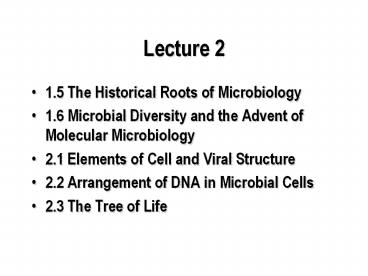1.5 The Historical Roots of Microbiology - PowerPoint PPT Presentation
Title:
1.5 The Historical Roots of Microbiology
Description:
Lecture 2 1.5 The Historical Roots of Microbiology 1.6 Microbial Diversity and the Advent of Molecular Microbiology 2.1 Elements of Cell and Viral Structure – PowerPoint PPT presentation
Number of Views:92
Avg rating:3.0/5.0
Title: 1.5 The Historical Roots of Microbiology
1
Lecture 2
- 1.5 The Historical Roots of Microbiology
- 1.6 Microbial Diversity and the Advent of
Molecular Microbiology - 2.1 Elements of Cell and Viral Structure
- 2.2 Arrangement of DNA in Microbial Cells
- 2.3 The Tree of Life
2
Also refer to Table 1.1
3
Louis Pasteur 1860 Where do the microorganisms
come from? Spontaneous generation?
(Madigan et al., Fig. 1.11)
Heat was used to kill the microorganisms in the
liquid
4
(Madigan et al., Fig. 1.11)
When dust was prevented from reaching the
sterilized liquid, no microorganisms grew in the
liquid
5
(Madigan et al., Fig. 1.11)
Contact with dust resulted in growth of
microorganisms in the liquid ? disproved
spontaneous generation
6
(No Transcript)
7
Robert Koch, 1870s Proof that microorganisms can
cause disease -germ theory of disease
(Madigan et al., Fig. 1.12)
Anthrax, caused by Bacillus anthracis Organism
present in the blood of all diseased animals -
cause or result of the disease?
8
Pure culture
(Madigan et al., Fig. 1.12)
9
(Madigan et al., Fig. 1.12)
10
(Madigan et al., Fig. 1.12)
Conclusion - specific organisms cause specific
disease Kochs postulates can be extended
beyond disease-causing organisms
11
comparative structure of prokaryotic and
eukaryotic cells
(Madigan et al., Fig 2.1)
- prokaryotic
- nucleoid
- no organelles
- eukaryotic
- nucleus
- organelles
12
bacterial cell, 1 x 3 µm (Heliobacterium modestica
ldum)
(Madigan et al., Fig. 2.2)
13
yeast cell, 8 µm dia (Saccharomyces cerevisiae)
14
viruses
- very small microorganisms (10s of nm dia), but
not cells - not dynamic open systems
- do not take nutrients or expel wastes
- static structure behave as more-or-less as
particles, except when infecting host - possess genes but no biosynthetic machinery
- rely on host machinery to reproduce
- viruses known to infect all cells
- viruses of bacteria bacteriophages
- see Madigan et al., Fig. 2.3a, b
15
relative sizes of different microorganisms
16
ribosomal RNA (rRNA) gene sequencing and
phylogeny
(Madigan et al., Fig. 2.6)
- all organisms possess ribosomes ? rRNAs useful
molecules for assessing relationships between
organisms - rRNA genes isolated
- gene sequences determined and compared
- phylogenetic tree depicts differences between
organisms analyzed
17
The Five Kingdoms of Life
- Plants
- Animals
- Fungi
- Monera (prokaryotes)
- Protists (slime molds, flagellates, Giardia)
- human-centric organization
18
The Three Domains of Life
19
(No Transcript)
20
(No Transcript)
21
Nomenclature
- Bacteria are named using the binomial system used
for other living things whereby each species is
given two names - The first name is the Genus name (equivalent to
your surname) and the second name is the species
name (equivalent to your Christian name) - Bacteria belong to the one species if they have
90 similarity of all observed characteristics - A group of similar species that have 80
similarity is called a Genus
22
Names and morphology
- The genus name always start with a capital letter
and the species name is in lower case and in
singular - e.g. Staphylococcus aureus
- Such binomial species names are always underlined
or written in Italics - e.g. Staphylococcus aureus
- e.g. not all streptococci are Streptococcus in
fact some streptococci are Leuconostoc - And not all staphylococci are Staphylococcus in
fact some staphylococci are Micrococcus - not all bacilli are Bacillus in fact some bacilli
are Chlostridium etc etc.
23
Criteria for Classification of Prokaryotes
Cultural Morphology Microscopic Morphology Cellular Components Growth Characteristics Metabolic Pathways Molecular Genetics
Location in Broth Cell Shape Cell Wall Atmospheric requirements Carbon requirements DNA base ratio
Colony Appearance Cell Size Gram Stain pH tolerance Nitrogen requirements DNA sequence
Pigmentation Arrangement Capsule Temperature requirements Sulfur requirements RNA sequence
Internal Structures Symbiotic lifestyle Fermentation Probes
Accessory Structures Antibiotic sensitivity Respiration PCR
End Products































